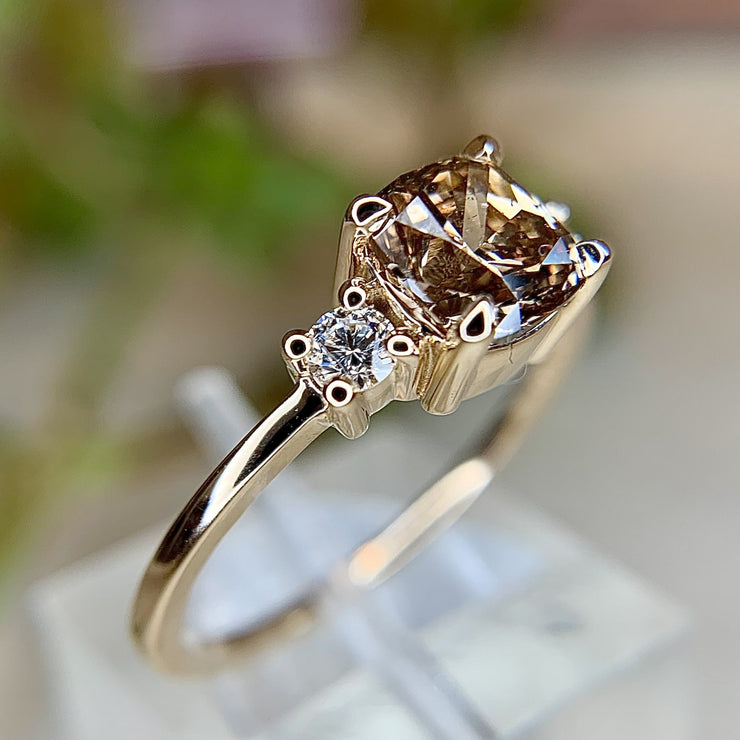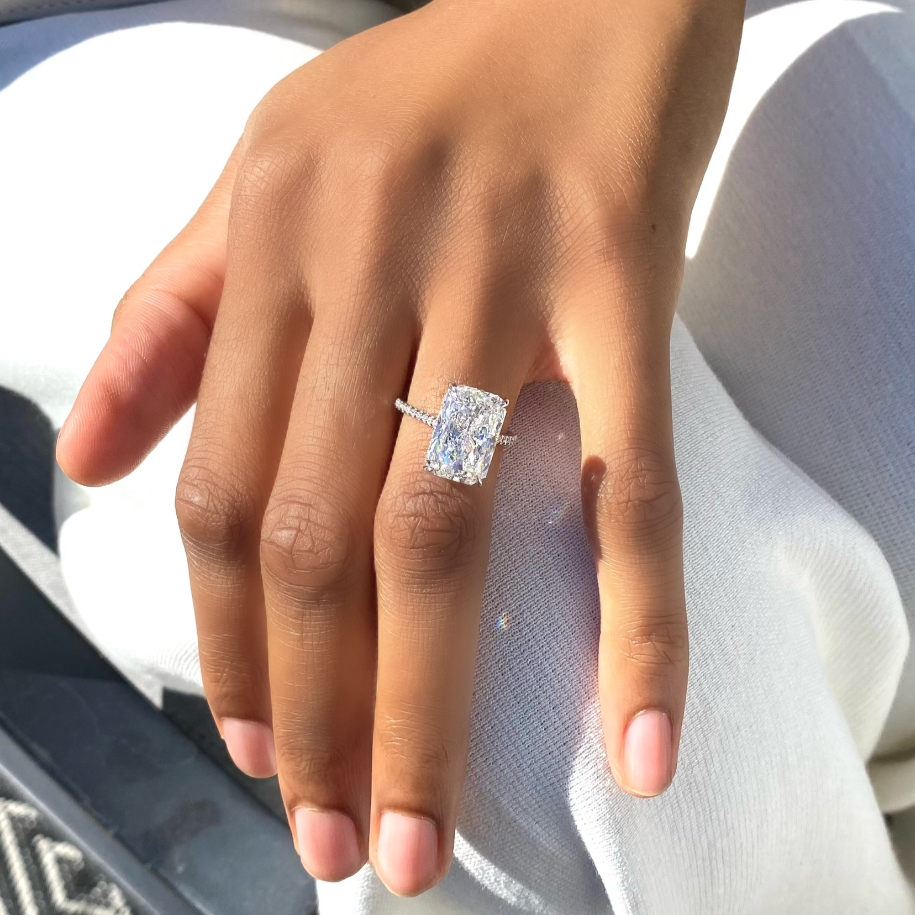The Advantages of Picking Lab Grown Diamond Engagement Rings for Your Proposition
Lab-grown Diamond engagement rings present an engaging choice for couples considering their proposal alternatives. These diamonds are ethically sourced and developed in controlled atmospheres, addressing both ethical and environmental concerns. Furthermore, they supply substantial cost savings, permitting bigger rocks or special styles. With innovations in technology, the charm of lab-grown rubies continues to grow. Understanding these benefits can affect a couple's decision-making procedure in profound ways. What elements should be focused on when making this option?
Moral Sourcing and Environmental Effect
As consumers increasingly prioritize sustainability, the surge of lab-grown Diamond involvement rings supplies an engaging alternative to traditionally mined diamonds. These lab-created treasures are generated in regulated atmospheres, significantly decreasing the ethical issues related to Diamond mining. Typical mining commonly includes exploitative labor practices and adds to ecological degradation, consisting of deforestation and environment devastation.

Cost-Effectiveness: More Value for Your Spending plan
Lab-grown Diamond interaction rings not only line up with ethical values yet also offer substantial price advantages. Typically, these rubies can be valued 20% to 40% lower than their mined equivalents, permitting pairs to maximize their spending plans without compromising high quality. This cost-effectiveness enables purchasers to buy bigger rocks or higher-quality settings, boosting the general visual of the ring.
Furthermore, the transparency in rates associated with lab-grown diamonds eliminates the hidden costs usually connected with extracted diamonds, such as qualification and transportation charges. Pairs can likewise gain from lower insurance premiums due to the minimized worth of lab-grown diamonds.
As an outcome, selecting a lab-grown Diamond engagement ring comes to be an economically savvy choice, offering pairs with more value for their cash. This affordability not just enables a better selection however additionally empowers couples to pick a ring that really shows their love and dedication.
Identical Physical and Chemical Features
The allure of lab-grown Diamond involvement rings exists not only in their honest manufacturing but likewise in their impressive physical and chemical buildings. These diamonds are produced in regulated research laboratory environments that resemble the natural problems under which rubies create in the Planet. Therefore, lab-grown diamonds possess the exact same crystal structure and firmness as their extracted equivalents, score an excellent 10 on the Mohs scale.
Both types of diamonds consist of carbon atoms prepared in a crystal latticework, guaranteeing similar optical and physical characteristics. Lab-grown rubies show the very same luster, fire, and scintillation as natural diamonds, making them indistinguishable to the naked eye. Advanced gemological testing is required to differentiate between the two, highlighting their authenticity. This parity in properties allows consumers to appreciate the charm and longevity of rubies while making an eco aware selection.
Bigger Selection of Choices
Laboratory grown Diamond engagement rings use a wider variety of design options that satisfy diverse tastes and choices. Their capability to be customized permits couples to create distinct pieces that mirror their individual design. This raised versatility not just boosts the ring's emotional worth but additionally makes it a more individual option.
Special Style Options
While conventional diamonds frequently include restricted style choices, the rise of lab-grown Diamond engagement rings has actually opened up a broader range of distinct designs and setups. This development enables couples to discover more creative styles, ranging from vintage-inspired to modern-day geometric shapes. Lab-grown diamonds can be crafted in different cuts, including oblong, pear, and heart forms, supplying versatility that allures to diverse preferences. Furthermore, the ability to combine these diamonds with unique band materials, such as rose gold or fairly sourced metals, improves the total aesthetic. With unique setups like halo or bezel, these rings can be customized to mirror individual stories and choices, making each engagement ring not just an icon of love, but likewise a standout item of art.
Modification Possibilities
A growing passion in lab-grown Diamond interaction rings has led to a boost in modification possibilities, allowing pairs to develop really customized items. Unlike traditional diamonds, lab-grown alternatives can be tailored to fit visit here private tastes and choices. Pairs can pick from a broader variety of forms, colors, and dimensions, enabling them to choose a diamond that resonates with their special design. In addition, customization extends beyond the Diamond itself; settings can be created to enhance the picked rock, whether one favors classic, modern, or elaborate designs. This adaptability not only boosts the emotional relevance of the ring but likewise enables a much more economical technique, as pairs can prioritize features that matter most to them without compromising on quality.
Openness in the Diamond Industry
How can customers browse the complexities of the Diamond sector when openness stays an important issue? The standard Diamond market typically lacks clear information concerning the origin and moral sourcing of rubies. This uncertainty can lead to customer mistrust and ethical problems surrounding problem rubies and environmental effect. Conversely, laboratory expanded diamonds supply a service to this openness issue. These diamonds are developed in controlled environments, permitting customers to access comprehensive information about their provenance.
Furthermore, respectable sellers of laboratory grown rubies usually provide certifications that describe the details of the Diamond's development, including its dimension, high quality, and the technology utilized. This level of openness encourages consumers to make enlightened selections, straightening their purchases with individual values. As understanding of underhanded practices in the Diamond sector grows, the clear, ethical nature of laboratory expanded rubies settings them as a compelling alternative for diligent consumers seeking engagement rings.
Sustaining Advancement and Technology
As the demand for fairly sourced gemstones increases, supporting technology and innovation in the lab-grown Diamond market ends up being essential (lab grown diamond engagement rings). Lab-grown rubies, developed with advanced approaches such as High Pressure High Temperature (HPHT) and Chemical Vapor Deposition (CVD), represent a significant shift in the Diamond industry. Investing in these innovations not just improves the top quality and accessibility of rubies yet additionally reduces environmental impact compared to conventional mining methods
Improvements in manufacturing methods their website have led to much more effective processes, resulting in decreased costs for customers. This technical progression fosters competitors, compelling conventional Diamond manufacturers to reevaluate their practices and adopt even more lasting techniques. By supporting lab-grown diamonds, customers add to a market that prioritizes ethical sourcing and development, eventually promoting an extra accountable and ecologically conscious fashion jewelry market. Embracing this brand-new age not just advantages consumers yet likewise encourages continued improvements in gemstone manufacturing innovations.

Customization and Modification Options
Laboratory grown Diamond engagement rings use a series of customization and customization choices that accommodate private choices. Consumers can choose one-of-a-kind style options and tailored rock characteristics, guaranteeing that each ring reflects individual style and value. This capacity to personalize improves the psychological value of the ring, making it a purposeful sign of dedication.
One-of-a-kind Style Selections
What makes a ruby involvement ring truly unique? Its unique design selections allow for deep customization, mirroring the pair's unique love story. Lab grown diamonds offer an array of options, from numerous cuts and settings to this custom-made engravings. Couples can choose from traditional jewelry to detailed halo layouts, guaranteeing their ring lines up with individual tastes. Additionally, the flexibility of laboratory expanded diamonds allows the consolidation of tinted gemstones, such as sapphires or emeralds, enhancing individuality. Modification encompasses the steel option, whether it's white gold, yellow gold, or increased gold. This flexibility in design not only develops a distinctive piece but also personifies the pair's commitment, making the engagement ring a remarkable sign of their special journey together.
Tailored Rock Characteristics
When taking into consideration the attributes of a ruby interaction ring, couples locate that tailored rock choices greatly boost the personalization procedure. Lab-grown rubies offer a variety of customizable attributes, allowing pairs to select the size, form, and color that ideal reflects their distinct design and preferences. This adaptability enables people to develop a ring that represents their romance. Additionally, pairs can pick certain quality levels and reduce designs, guaranteeing that the Diamond not just meets their aesthetic needs but additionally fits their budget. With lab-grown rubies, the opportunity for personalization reaches establishing kinds and metal selections, further improving the ring's individuality. Eventually, customized rock features encourage pairs to design a meaningful engagement ring that really represents their partnership.
Often Asked Concerns
Just How Do Laboratory Grown Diamonds Contrast to Natural Diamonds in Regards To Toughness?
Lab grown rubies and all-natural diamonds show similar toughness, as both are made up of carbon and share similar firmness degrees. This makes them just as immune to damaging and damages, ensuring durability in any type of jewelry setting.
Can Lab Grown Diamonds Be Resold or Appraised Like Natural Diamonds?
Laboratory grown diamonds can undoubtedly be re-selled and assessed likewise to natural diamonds. However, their resale worth might vary because of market perceptions and the expanding schedule of lab-created alternatives in the precious jewelry industry.
What Is the Distinction in Sparkle In Between Laboratory Grown and Natural Diamonds?

Do Laboratory Grown Diamonds Include Certifications Like Natural Diamonds?
Laboratory grown diamonds do feature accreditations, similar to all-natural rubies. These certifications validate their top quality, consisting of aspects like cut, carat weight, color, and clarity weight, guaranteeing customers obtain a reputable analysis of their purchase.
Exactly How Are Laboratory Grown Diamonds Made to begin with?
Lab grown diamonds are created with 2 key methods: High Pressure High Temperature (HPHT) simulates all-natural procedures, while Chemical Vapor Deposition (CVD) uses gases to deposit carbon, enabling for regulated Diamond development in a research laboratory environment. lab grown diamond engagement rings.
As consumers increasingly prioritize sustainability, the increase of lab-grown Diamond interaction rings supplies an engaging choice to typically extracted rubies. In addition, the openness in pricing linked with lab-grown rubies eliminates the concealed costs commonly linked with mined diamonds, such as qualification and transportation charges. Lab-grown rubies display the very same luster, fire, and scintillation as natural diamonds, making them indistinguishable to the nude eye. While typical rubies often come with minimal layout choices, the surge of lab-grown Diamond interaction rings has actually opened up a more comprehensive range of unique styles and settings. Lab-grown rubies, produced through innovative methods such as High Stress High Temperature Level (HPHT) and Chemical Vapor Deposition (CVD), stand for a substantial change in the Diamond sector.